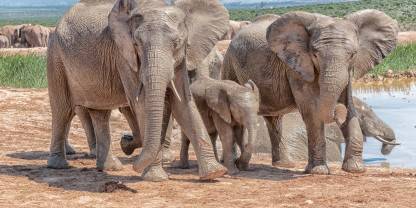
Climate Chart Addo Elephant National Park – 0-901m / 0-2,956ft
Addo Elephant National Park receives an average rainfall of less than 450mm/18in per year. Unlike the summer rainfall pattern across most of the country, rainfall is relatively evenly distributed throughout the year. However, there are two peaks: in February–March and October–November. It can cool down to freezing in midwinter. The park covers a wide range of altitudes, but the main tourist area is under 250m/820ft.
Winter May to September
The winter months are very cold at night and in the early morning. It is advisable to bring warm clothes, especially for open-vehicle . Winter sees even less rainfall than summer and the skies are usually clear.
- May – This is the beginning of winter. Temperatures cool down to a typical 9°C/48°F in the morning and 22°C/72°F in the afternoon.
- June & July – These are the coldest months. The average morning temperature is 7°C/45°F, but it sometimes gets to freezing at night. Afternoon temperatures are around 19°C/66°F.
- August & September – It is gradually getting warmer, with an average temperature of 21°C/70°F in the afternoon. Mornings are not quite as cold with temperatures around 9°C/48°F.
Summer October to April
Summer has more comfortable temperatures and a bit more rainfall. Some days might be cloudy, and occasional rainstorms occur, but mostly it is sunny.
- October & November – It gets warmer, and temperatures are between 13°C/55°F in the morning and 24°C/75°F in the afternoon. October is a peak month for rain, but even then it doesn’t rain on most days.
- December, January & February – These are the warmest months with afternoon temperatures reaching 28°C/82°F. Mornings are comfortable at about 16°C/61°F. December and January have less rain, but this picks up a bit in February.
- March & April – March is the wettest month, but it seldom rains for days on end. It starts to cool down again with an average daytime temperature of 26°C/79°F in the afternoon and 14°C/57°F in the morning.

